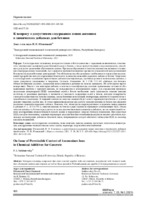| dc.contributor.author | Юхневский, П. И. | |
| dc.coverage.spatial | Минск | ru |
| dc.date.accessioned | 2021-10-07T05:29:13Z | |
| dc.date.available | 2021-10-07T05:29:13Z | |
| dc.date.issued | 2021 | |
| dc.identifier.citation | Юхневский, П. И. К вопросу о допустимом содержании ионов аммония в химических добавках для бетонов = On Issue of Permissible Content of Ammonium Ions in Chemical Additives for Concrete / П. И. Юхневский // Наука и техника. – 2021. – № 5. – С. 420-426. | ru |
| dc.identifier.uri | https://rep.bntu.by/handle/data/103445 | |
| dc.description.abstract | Азотсодержащие соединения, которые поступают в бетон совместно с сырьевыми компонентами, в частности с химическими модификаторами бетонной смеси и бетона, а также присутствующие в портландцементе, способны в результате разложения образовывать аммиак. Процессы образования и эмиссии аммиака как вызывают ухудшение атмосферы жилых помещений, так и являются причиной понижения прочности и показателей эксплуатационной безопасности железобетонных конструкций. Эти обстоятельства обусловливают необходимость проведения исследований и разработки методов определения безопасного количества аммонийсодержащих добавок в бетоне. Чаще всего в азотсодержащих соединениях присутствуют добавки-пластификаторы, противоморозные и комплексные добавки, а также ускорители схватывания и твердения. Согласно Изменению № 2 СТБ 1112–98 «Добавки для бетонов. Общие технические условия», содержание ионов аммония в добавках не должно превышать 100 мг/кг (кроме противоморозных). Вместе с тем некоторые добавки, в том числе пластификаторы, успешно применяемые не один год без выявленных проблем с эмиссией аммиака, не укладываются в установленную норму. Для определения предельно допустимых концентраций (ПДК) аммонийных солей в бетоне необходимо знать зависимость эмиссии аммиака из бетона от различных факторов, в частности от массового содержания солей в бетоне, площади поверхности, с которой осуществляется эмиссия аммиака, массы бетонных конструкций, температуры, влажности и кратности воздухообмена в помещении. В меньшей степени на эмиссию аммиака будут влиять характеристики бетона и условия реакции гидролиза солей в нем. В статье приведены формулы для расчета эмиссии аммиака из бетона при введении различных аммонийсодержащих добавок. Показано, что, несмотря на сверхнормативное содержание ионов аммония в добавках С-3, ЛСТ и УП-4, эмиссия аммиака из бетона в ряде случаев не превышает установленных ПДК. Объем эмиссии аммиака из бетона определяется не только количеством ионов аммония в добавках, но и в значительной степени конструктивно-технологической схемой здания и параметрами загрузки бетоном помещения. При известных ПДК в воздухе помещения, заданных параметрах загрузки бетоном помещения формулы позволяют рассчитать предельную концентрацию добавки в бетонной смеси, непревышение которой обеспечит соблюдение ПДК по аммиаку в воздухе помещений. | ru |
| dc.language.iso | ru | ru |
| dc.publisher | БНТУ | ru |
| dc.title | К вопросу о допустимом содержании ионов аммония в химических добавках для бетонов | ru |
| dc.title.alternative | On Issue of Permissible Content of Ammonium Ions in Chemical Additives for Concrete | ru |
| dc.type | Article | ru |
| dc.identifier.doi | 10.21122/2227-1031-2021-20-5-420-426 | |
| local.description.annotation | Nitrogen-containing compounds that enter concrete together with raw materials, in particular with chemical modifiers of concrete mixture and concrete, as well as those present in Portland cement, are capable of forming ammonia as a result of decomposition. The processes of formation and emission of ammonia cause both a deterioration of the atmosphere of residential premises and are the reason for a decrease in the strength and operational safety indicators of reinforced concrete structures. These circumstances necessitate research and development of methods for determining the safe amount of ammonium-containing additives in concrete. Most often, nitrogen-containing compounds contain plasticizing additives, antifreeze and complex additives, as well as setting and hardening accelerators. According to Amendment No 2 STB (Standards of the Republic of Belarus) 1112–98 “Additives for Concrete. General Requirements”, the content of ammonium ions in additives should not exceed 100 mg/kg (except for antifreeze). At the same time, some additives, including plasticizers, which have been successfully used for more than one year without identified problems with ammonia emission, do not fit into the established norm. To determine the maximum permissible concentration (MPC) of ammonium salts in concrete, it is necessary to know the dependence of the emission of ammonia from concrete on various factors, in particular, on the mass content of salts in concrete, the surface area from which ammonia is emitted, the mass of concrete structures, temperature, humidity and air exchange rate in the room. To a lesser extent, the ammonia emission will be affected by the characteristics of the concrete and the reaction conditions for the hydrolysis of salts in the concrete. The paper provides formulas for calculating the emission of ammonia from concrete with the introduction of various ammonium-containing additives. It is shown that, in spite оf the above-standard content of ammonium ions in additives C-3, LST and UP-4, the emission of ammonia from concrete in some cases does not exceed the established maximum permissible concentration (MPC). The volume of ammonia emission from concrete is determined not only by the amount of ammonium ions in the additives, but also to a large extent by the structural and technological scheme of the building and the parameters of the concrete loading of the room. With the known MPC in the air of the room, the given parameters of loading the room with concrete, the formula allows you to calculate the maximum concentration of the additive in the concrete mixture, not exceeding which will ensure compliance with the MPC for ammonia in the air of the premises. | ru |

